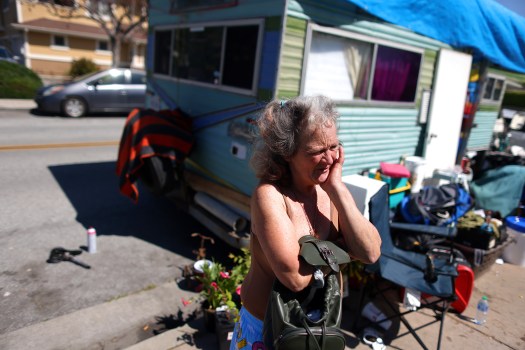Tami Rule is positioned outside the vehicle she calls home on Sandpebble Drive in San Jose, California, on Wednesday, April 3, 2024. San Jose has initiated a trial initiative employing artificial intelligence (AI) to detect inhabited RVs and homeless settlements.
Cities nationwide are exploring the applications of AI in various domains such as mapping potholes, traffic management, and wildfire prevention. In San Jose, officials are leveraging this rapidly advancing technology to pinpoint homeless encampments.
A city-owned Toyota sedan equipped with multiple small cameras has traversed South San Jose thrice since December to capture footage of parked vehicles and RVs. This footage was then processed by AI systems developed by four private firms to ascertain if individuals were residing inside these vehicles.
This innovative pilot program, believed to be a pioneering effort on a national scale, may extend its scope to identifying tent encampments in the near future and potentially evolve into a permanent fleet covering the entire city.
While advocates for the homeless express concerns that this initiative might lead to increased sweeps of encampments and impounding of inhabited RVs, city authorities remain hopeful that it will facilitate connecting homeless individuals with essential services, shelter, or housing. It is emphasized that the program does not intend to capture identifiable information such as license plate numbers or individuals’ faces.
San Jose Mayor Matt Mahan stated, “We are not interested in the personal identities of individuals living on the streets. However, it is crucial for us to have a comprehensive understanding of all inhabited vehicles within the city to effectively manage them.”
This program, initially disclosed by The Guardian, aligns with Mahan’s efforts to eradicate street encampments, responding to residents’ escalating concerns regarding homelessness.
In addition to addressing encampments, San Jose’s pilot scheme aims to identify issues like litter, graffiti, potholes, and parking violations. While other cities utilize AI for similar purposes, San Jose appears to be at the forefront in utilizing this technology to detect RVs or tents housing individuals, as noted by AI experts and national homeless advocates.
Tami Rule, who relocated to an RV following a fire that ravaged her apartment in San Jose, expressed her apprehensions about potential intrusion into their personal space through the recorded footage of their belongings stored outside the vehicle.
In contrast, neighboring cities such as San Francisco, Oakland, Fremont, and Mountain View have indicated no intentions of employing AI for tracking encampments.
However, experts foresee a trend where cities might emulate San Jose’s approach. Recently, Mahan hosted a virtual forum with White House officials and local government representatives nationwide to explore the integration of AI for enhancing public services.
Vishnu Pendyala, an AI professor at San Jose State University, acknowledged the significant potential of AI in detecting homeless settlements but highlighted the privacy concerns associated with such initiatives.
The city and collaborating companies have emphasized the paramount importance of safeguarding individuals’ privacy by instructing AI systems to disregard faces and license plate numbers.
Khaled Tawfik, San Jose’s chief information officer, affirmed that privacy protection is a primary focus of the program. The city is not sharing any data with other agencies during the pilot, and any future distribution of data or footage will obscure identifiable details.
Initiated to address the numerous 311 calls reporting seemingly abandoned vehicles, the program aims to proactively identify inhabited vehicles for targeted homeless outreach efforts. The pilot has achieved a 70% accuracy rate in identifying lived-in RVs but only 10% to 15% accuracy in recognizing inhabited cars.
Despite the technology’s potential, there is an acknowledgment of potential errors. The involved companies, including Xloop Digital, Sensen.AI, CityRover, and Blue Dome Technologies, are striving to enhance accuracy through further analysis of images.
Todd Langton, executive director of Agape Silicon Valley, expressed concerns that the program could intensify the city’s efforts to clear RVs from its streets, potentially leading to the displacement of unhoused individuals and loss of personal belongings.
While residents advocate for stricter measures against vehicle and tent encampments, city officials are committed to ensuring safe alternatives for homeless individuals. Efforts are underway to establish tiny home shelters and overnight parking facilities with supportive services. Despite these initiatives, challenges persist due to the shortage of adequate housing and shelter options.
In conclusion, the city’s endeavors to address homelessness through innovative AI applications are met with a mix of optimism and apprehension from various stakeholders, reflecting the complex and multifaceted nature of the issue.










